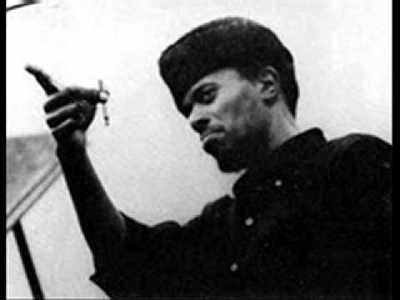Sun, smiles, kids dancing around -- the vibe of this MLK Day concert was a lot like that of the Pan Afrikan Peoples Arkestra massives at Watts Towers back in the 1970s. Even the location, on the patio of the County Museum of Art, didn't ring so different. In South L.A., the proximate art had been Simon Rodia's spacy helix needles. A parallel experience, just closed at LACMA a week previous: the exhibit of ancient Olmec art, its giant heads and human/animal statuary fusing flashes of Mexico, China and Africa appropriate to Los Angeles, the ultimate multiculti hub. It raised thoughts of Roberto Miranda soul-gripping his bass with the Arkestra in 1979, and of Arkestra leader Horace Tapscott composing a piece for pianist Jon Jang in 1998, the year before Tapscott crossed over. E pluribus unum.
The Arkestra continues to perform semiregularly under the direction of longtime member Michael Session, who did not fail to keep the continuity rolling. His own 15-year-old son drove the 17-member ensemble with whirlwind trap drums; tenor saxist Randall Fischer, already confident when I saw him two years ago at age 18, was now a dynamo of controlled rhythm and challenging invention. Old hands? Oh yeah: Derf Reklaw and Don Littleton behind hand drums, Azar Lawrence blowing up a tenor storm, Maia cooling out lovely lines on flute and piccolo. In between, agewise: Trevor Ware, a total rock on the essential bass riffs, and trumpeter Richard Grant (formerly of Black Note, the hope of local jazz 20 years back) stirring up the biggest response of the day with his sorrowful blue tone and defiant stinging high notes. I'm gonna omit many genii, nearly all of whom soloed, but must take note of Isaac Smith, who boiled a deep avant caldron with his big-belled trombone.
It would hardly have deserved to be called an Arkestra performance without an intermission by Kamau Da'ood, who not only belted out his famous Horace Tapscott poem, but stepped up with a couple of hand shakers to bring the group rhythm together after a loose start on the concluding Arkestra jam, Charles Mingus' hard-to-swing "Boogie Stop Shuffle."
What a roar the Arkestra blasted forth, and so flexible -- made CGI dinosaurs seem fossilized. The formula: Men & women got some primeval Tapscott riff going, maybe some flutes drifted in, the drummers established the heartbeat, and everybody stood up in solo sequence like the spine plates of a stegosaurus; average tune length, 15 minutes. It warmed the heart to hear "Sonny's Dream," the summery & hallucinatory Tapscott waltz that keynoted Sonny Criss' most ambitious record back in 1968. (And the 2011 version, whatever your expectations, rose higher.)
At the conclusion of the Ark set, Session betook himself to speechifying about the conspiracy against jazz and the dumbing down of the airwaves. After making all his quite worthwhile points in the first half minute, he gusted onward for a quarter hour with approximately one ten-thousandth of the eloquence he exhibited in any four bars of his inflammatory reedwork. It was enough to prod us into jotting a memo to buy some underwear from the afternoon's sponsor, Target. Although am I the only one who finds the association of that name with Martin Luther King Jr. questionable?
The Arkestra's opening bookend was the invigorating five-drummer ensemble of J.J. Kabasa, which crushed all resistance and dispersed the evil spirits. The closing bookend was the singing & swaying women & men of the Great Voice of UGMAA, conducted by Dwight Trible on his own "Little Africa" to inspire memories of the motherland church. A kid let her balloon slip, and it drifted up to lodge against the aquamarine canopy panels high above. Can't plan something that perfect.
What a program, and free to boot; there must be some sonority left in the old liberty bell after all. "We keep our ancestors alive by speaking their names," said Da'aood. They keep us alive, too.

